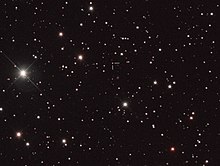
Back ثقب أسود A0620-00 Arabic A0620-00 Czech A0620−00 German A0620-00 Spanish 1A 0620-00 French A0620-00 Italian いっかくじゅう座X-1 Japanese A0620-00 Korean A0620-00 Dutch A0620-00 Portuguese
| Observation data Epoch J2000 Equinox J2000 | |
|---|---|
| Constellation | Monoceros |
| Right ascension | 06h 22m 44.542s[2] |
| Declination | −00° 20′ 44.29″[2] |
| Apparent magnitude (V) | 11.2[3] |
| Characteristics | |
| Evolutionary stage | Black hole + main sequence[4] |
| Spectral type | K2 V[5] |
| Variable type | X-ray nova, Ellipsoidal[6] |
| Astrometry | |
| Radial velocity (Rv) | −5±12[7] km/s |
| Proper motion (μ) | RA: −0.439 mas/yr[2] Dec.: −5.138 mas/yr[2] |
| Parallax (π) | 0.6969 ± 0.1168 mas[2] |
| Distance | approx. 4,700 ly (approx. 1,400 pc) |
| Orbit | |
| Period (P) | 7.75234 ± 0.00010[7] hr |
| Inclination (i) | 50.98 ± 0.87[4]° |
| Periastron epoch (T) | JD 2446082.7481 ± 0.0008[7] |
| Semi-amplitude (K1) (primary) | 457 ± 8[7] km/s |
| Details | |
| Black hole | |
| Mass | 5.86±1.24[8] M☉ |
| Star | |
| Mass | 0.34±0.03[8] M☉ |
| Radius | 1.057[9] R☉ |
| Luminosity | 0.44[9] L☉ |
| Surface gravity (log g) | 5.0[5] cgs |
| Temperature | 5,000[5] K |
| Metallicity [Fe/H] | 0.0[5] dex |
| Rotational velocity (v sin i) | 83.8±1.9[5] km/s |
| Other designations | |
| Database references | |
| SIMBAD | data |
A0620-00 (abbreviated from 1A 0620-00) is a binary star system in the constellation of Monoceros, with an apparent magnitude of 11.2.
A0620-00 consists of two objects. The first object is a K-type main-sequence star.[4][5] The second object cannot be seen, but based on its calculated mass of about 6 M☉,[8][4] it is too massive to be a neutron star and must therefore be a stellar-mass black hole.[7] The two objects orbit each other every 7.75 hours.[7] At a distance of roughly 3,300 light-years (1,000 parsecs) away, the black hole of A0620-00 would be one of the nearest known black holes to the Solar System, closer than GRO J1655-40.[10]

A0620-00 has undergone two X-ray outbreaks. The first one was in 1917.[11] The second burst, in 1975, was detected by the Ariel 5 satellite.[12] During that time, A0620-00 was the brightest X-ray point source.[7] It is now classified as an X-ray nova.[7] Its black hole nature was determined in 1986.[7]
The black hole in A0620-00 pulls matter from the K-type star into an accretion disk.[4] The accretion disk emits significant amounts of visible light and X-rays. Because the K-type star has been pulled into an ellipsoidal shape, the amount of surface area visible, and thus the apparent brightness, changes from the Earth's perspective. A0620-00 also bears the variable star designation V616 Monocerotis.[6]
- ^ Cite error: The named reference
vG2017was invoked but never defined (see the help page). - ^ a b c d Brown, A. G. A.; et al. (Gaia collaboration) (2021). "Gaia Early Data Release 3: Summary of the contents and survey properties". Astronomy & Astrophysics. 649: A1. arXiv:2012.01533. Bibcode:2021A&A...649A...1G. doi:10.1051/0004-6361/202039657. S2CID 227254300. (Erratum: doi:10.1051/0004-6361/202039657e). Gaia EDR3 record for this source at VizieR.
- ^ a b "1A 0620-00". SIMBAD. Centre de données astronomiques de Strasbourg. Retrieved 26 August 2017.
- ^ a b c d e Cantrell, Andrew G.; Bailyn, Charles D.; Orosz, Jerome A.; McClintock, Jeffrey E.; Remillard, Ronald A.; Froning, Cynthia S.; Neilsen, Joseph; Gelino, Dawn M.; Gou, Lijun (2010). "The Inclination of the Soft X-Ray Transient A0620-00 and the Mass of its Black Hole". The Astrophysical Journal. 710 (2): 1127–1141. arXiv:1001.0261. Bibcode:2010ApJ...710.1127C. doi:10.1088/0004-637X/710/2/1127. S2CID 33906909.
- ^ a b c d e f Zheng, Wan-Min; Wu, Qiaoya; Wu, Jianfeng; Wang, Song; Sun, Mouyuan; Guo, Jing; Liu, Junhui; Yi, Tuan; Zhang, Zhi-Xiang; Gu, Wei-Min; Wang, Junfeng; Gou, Lijun; Liu, Jifeng; Callanan, Paul J.; Ho, Luis C.; Longa-Peña, Penélope; Orosz, Jerome A.; Reynolds, Mark T. (2022), "The Disk Veiling Effect of the Black Hole Low-mass X-Ray Binary A0620-00", The Astrophysical Journal, 925 (1): 83, arXiv:2112.07842, Bibcode:2022ApJ...925...83Z, doi:10.3847/1538-4357/ac4332, S2CID 245144462
- ^ a b Samus, N. N.; Durlevich, O. V.; et al. (2009). "VizieR Online Data Catalog: General Catalogue of Variable Stars (Samus+ 2007-2013)". VizieR On-line Data Catalog: B/GCVS. Originally Published in: 2009yCat....102025S. 1. Bibcode:2009yCat....102025S.
- ^ a b c d e f g h i McClintock, J. E.; Remillard, R. A. (1986). "The black hole binary A0620-00". Astrophysical Journal. 308: 110–122. Bibcode:1986ApJ...308..110M. doi:10.1086/164482.
- ^ a b c Van Grunsven, Theo F. J.; Jonker, Peter G.; Verbunt, Frank W. M.; Robinson, Edward L. (2017), "The mass of the black hole in 1A 0620-00, revisiting the ellipsoidal light curve modelling", Monthly Notices of the Royal Astronomical Society, 472 (2): 1907, arXiv:1708.08209, Bibcode:2017MNRAS.472.1907V, doi:10.1093/mnras/stx2071
- ^ a b Stassun, Keivan G.; et al. (1 October 2019), "The Revised TESS Input Catalog and Candidate Target List", The Astronomical Journal, 158 (4): 138, arXiv:1905.10694, Bibcode:2019AJ....158..138S, doi:10.3847/1538-3881/ab3467, hdl:1721.1/124721, ISSN 0004-6256, S2CID 166227927.
- ^ Foellmi, Cédric (2009). "What is the closest black hole to the Sun?". New Astronomy. 14 (8): 674–691. arXiv:0812.4232. Bibcode:2009NewA...14..674F. doi:10.1016/j.newast.2009.04.003. S2CID 12843219.
- ^ Eachus, L. J.; Wright, E. L.; Liller, W. (1976). "Optical observations of the recurrent nova associated with A0620-00 - 1917-1975". Astrophysical Journal. 203: L17–L19. Bibcode:1976ApJ...203L..17E. doi:10.1086/182009.
- ^ Elvis, M.; Page, C. G.; Pounds, K. A.; Ricketts, M. J.; Turner, M. J. L. (1975). "Discovery of powerful transient X-ray source A0620-00 with Ariel V Sky Survey Experiment". Nature. 257 (5528): 656–657. Bibcode:1975Natur.257..656E. doi:10.1038/257656a0. S2CID 4160399.
